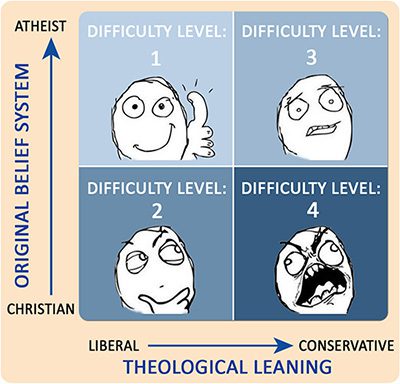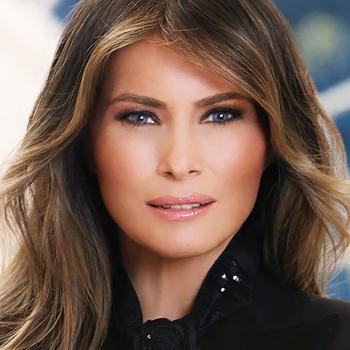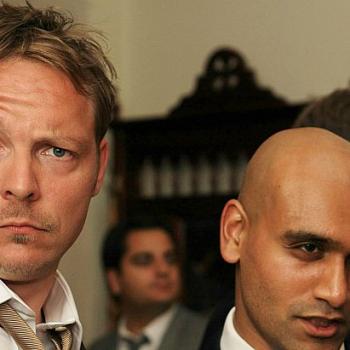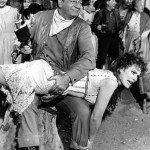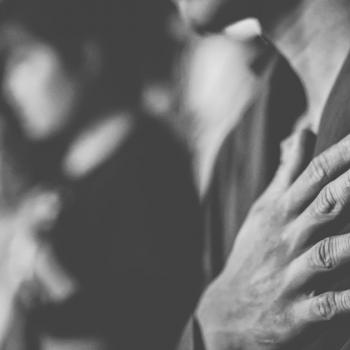Last Sunday I would have celebrated my 18th wedding anniversary if not for the fact that we divorced not long after our 16th. After fourteen pretty good years and after bringing four beautiful girls into the world together, we hit an obstacle we didn’t have the right tools to overcome. It would be more precise to say we hit a pile of obstacles since rarely does a marriage disintegrate because of just one thing. We weren’t really prepared for handling the kinds of conflict we encountered, so consequently we didn’t navigate those challenges successfully. Resolving marital conflict requires compromise, but we inhabited a world that views compromise as a bad word. In the end we found that our marriage wasn’t equipped to deal with differences like this.
We entered our marriage in large part because of a mutual commitment to a common faith. Our similar passions for Christian ministry drew us together in the first place, and it was that common vision that enabled us to connect the way we did all those years. But a time came when I realized I no longer shared that faith, and that change hit us both very hard. She felt betrayed, as if someone had switched her husband out for another man. This wasn’t the marriage she agreed to so many years ago. We were supposed to be a Christian couple, and I was supposed to be her spiritual companion, her partner in the faith. Now she was left feeling like someone had pulled a bait-and-switch on her, and she was left alone in her faith. This kind of crisis has no easy answers.
We needed help. More precisely we needed the kind of assistance that could help us navigate ideological differences of a magnitude we had never faced before. I am sad to say we were unable to locate those resources at the time because as I said, in our world compromise was a bad thing. In that world, any change in agreements and commitments represents a falling away from something ideal, a degradation of the purity we once had. When you believe your relationship was crafted by divine providence, a major change in that relationship signals a departure from the only way that’s right. I wish more than anything that when we turned to look for help we had found the kind of help that envisioned a way through our differences which could have framed everything in terms that accommodated both worlds we had come to inhabit. We just weren’t prepared for this.
When we said our vows we promised to love each other for better or for worse, for richer or for poorer, and in sickness and in health. But we left one out. We should have said “in faith and in doubt,” because in the end that’s the one that did us in.
In Faith and In Doubt
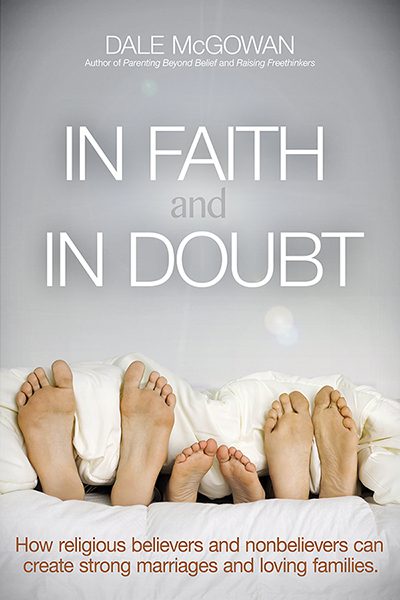 I so wish this book had existed four years ago when we first hit that wall. Dale McGowan spent the better part of four years researching “mixed faith” relationships in order the find out what made some relationships flourish while others fizzled. He studied nearly a thousand couples from just about every sacred/secular combination imaginable and distilled what they reported down into a handful of clues, warning signs, and “best practices” among couples working through these differences. Some couples entered their relationships already aware of their disparate worldviews; often they worked through their differences early on. Other couples began on the same page but later had one or both spouses convert (or deconvert) to a different faith over the course of their relationship. Those are considerably more challenging, but many of them made it through their transitions quite well despite what many people told them would surely spell their doom.
I so wish this book had existed four years ago when we first hit that wall. Dale McGowan spent the better part of four years researching “mixed faith” relationships in order the find out what made some relationships flourish while others fizzled. He studied nearly a thousand couples from just about every sacred/secular combination imaginable and distilled what they reported down into a handful of clues, warning signs, and “best practices” among couples working through these differences. Some couples entered their relationships already aware of their disparate worldviews; often they worked through their differences early on. Other couples began on the same page but later had one or both spouses convert (or deconvert) to a different faith over the course of their relationship. Those are considerably more challenging, but many of them made it through their transitions quite well despite what many people told them would surely spell their doom.
And that is one of the main points of this book. Religious communities often feel the need to push their members to preserve the identity markers of their group, leading them to assume a corrective posture toward the divergent partner in the relationship. They can become a discouraging influence on the relationship, making it much harder for the couples to maintain open and mutually respectful lines of communication. But Dale’s research found that couples in these mixed faith marriages usually fared much better than their critics predicted. Sure, they didn’t always turn out okay in the end. Sometimes the differences proved too many and too important to allow for a positive and healthy ongoing relationship. But more often than not he found that with enough mutual respect and open communication these couples were able to navigate their differences for better rather than for worse.
Couples in mixed faith marriages will find this book an invaluable resource for starting fruitful discussions about their religious disagreements because it breaks down the difference between beliefs and values. I recently wrote about this very distinction:
It is my observation that two people with the same beliefs can have wildly different character; by the same token, two people from very different belief systems can have virtually identical values. For this reason, I would argue that for most issues pertaining to daily life, common values rather than common beliefs should form the basis of our closest relationships.
This means that couples in mixed faith marriages have a basis for finding common ground if only they can take the time to look at shared values rather than framing everything around their differences of belief. It can be tricky sometimes delineating which things fall into which category because some systems of belief will scarcely allow for this distinction. But for the vast majority of relationships, there are enough opportunities for finding common ground that they can move past these differences and build strong and healthy marriages.
But this doesn’t just pertain to marriages, does it? Learning to appreciate common values and learning to respect each other despite ideological differences works for every kind of relationship, don’t you think? That’s one of the things that appeals to me most of all as I read this book. This topic is very near and dear to my heart for the simple reason that most of my primary relationships are “mixed faith relationships.” The ending of my marriage didn’t remove this tension from my life. At the time I deconverted, my family and friends were virtually all evangelical believers, and almost all of them still are today. Since that time, I’ve made a large number of new friends who share my skepticism toward all things supernatural, but many of those old relationships remain important to me today. That means that if I want to maintain healthy relationships with virtually anyone in my personal life, it behooves me to learn to look at what makes relationships thrive despite the differences of religious belief we encounter.
Why I Love This Book
Besides the importance of this topic to my daily life, I love how well-researched and how clearly organized this book is. Dale begins by talking about how nuanced and varied religious belief (as well as non-belief) can be, and how a complex mix of influences can place people from either camp anywhere on a wide spectrum of faith and doubt. He then lists nine potential obstacles which often get in the way of healthy communication and mutual understanding, followed by ten “best practices” of couples wrestling through their sacred/secular divide.
He goes on to illustrate how these dynamics play out through the stories of nine couples whose religious differences run the gamut of possibilities. There are Catholics, Baptists (liberal, conservative, and Southern), nondenominationals, atheists and agnostics, a Hindu, a “none,” and even a couple of Pentecostals in this mix of divergent relationships. Following their stories, you can see how many different ways these conflicts can be handled, all depending on the unique mix of backgrounds, personalities, and priorities which characterize each relationship. If nothing else, this book should give hope to those who worry that there can be no productive way forward for those couples who find themselves divided by their religious differences. This passage sums up the aim of the book very well:
In Faith and In Doubt puts the secular/religious mixed marriage in a cultural context, counters the hair-pulling naysayers, tells the stories of real couples who have succeeded as well as some who’ve failed (and why), and offers suggestions and strategies for ending up in the success column.
Because of the importance of this struggle for my own relationships and for the growing number of my friends who write me to tell me they are going through the very same thing, I’ve been eagerly awaiting the release of this book. I highly recommend it for anyone who currently lives in a mixed faith relationship (and yes, I know atheism isn’t a faith but cut me some slack on the nomenclature; these things are complicated). Order a copy of this book and read it together with your spouse to see if it can open up some lines of communication between you. Or if nothing else, read it as a resource for yourself. In the absence of a qualified and unbiased counselor to help you navigate these choppy waters, this book may be the best thing you’ll come across. Read it to clarify your own thoughts about how to approach your differences in a way that is respectful, sensitive, and mutually beneficial.
I’d be remiss if I didn’t admit that some mixes work better than others, and sometimes these conflicts can’t be fully resolved. Some couples stay together and just agree to disagree; others agree to disagree from a much farther distance. Some kinds of personalities just don’t handle these conflicts well. Furthermore, the kind of religious background each person came from can highly color how these differences are framed as well. In my own article giving “Advice for the Unequally Yoked,” I put together a little chart to illustrate the level of difficulty each type of combination will likely expect:
You can be sure that I’ll be writing more about this in the coming weeks. I probably get more emails and private messages about this single topic than anything else (other than asking advice on how to “come out” as an atheist to religious friends and family). To be honest, I’m still unpacking my own history as I read through this book. And I hope to glean some helpful advice for maintaining good relationships with friends and family from this point forward. So stay tuned.

